
Wolf spiders are members of the family Lycosidae. They are robust and agile hunters with excellent eyesight. They live mostly in solitude, hunt alone, and usually do not spin webs. Some are opportunistic hunters, pouncing upon prey as they find it or chasing it over short distances; others wait for passing prey in or near the mouth of a burrow.

The family Dipluridae, known as curtain-web spiders are a group of spiders in the infraorder Mygalomorphae, that have two pairs of booklungs, and chelicerae (fangs) that move up and down in a stabbing motion. A number of genera, including that of the Sydney funnel-web spider (Atrax), used to be classified in this family but have now been moved to Atracidae.

The Mesothelae are a suborder of spiders that includes a single extant family, Liphistiidae, and a number of extinct families. This suborder is thought to form the sister group to all other living spiders, and to retain ancestral characters, such as a segmented abdomen with spinnerets in the middle and two pairs of book lungs. Members of Liphistiidae are medium to large spiders with eight eyes grouped on a tubercle. They are found only in China, Japan, and southeast Asia. The oldest known Mesothelae spiders are known from the Carboniferous, over 300 million years ago.

Ground spiders comprise Gnaphosidae, the seventh largest spider family with over 2,000 described species in over 100 genera distributed worldwide. There are 105 species known to central Europe, and common genera include Gnaphosa, Drassodes, Micaria, Cesonia, Zelotes and many others. They are closely related to Clubionidae. At present, no ground spiders are known to be seriously venomous to humans.

Liocranidae is a family of araneomorph spiders first described by Eugène Simon in 1897. They are one of several groups called "sac spiders". The holarctic genus Agroeca is the best-known, but it also includes various genera of more obscure spiders that still lack a diagnosis. Two species in the North American genus Neoanagraphis are found in the extremely dry conditions in the Mojave, Sonoran and Chihuahuan deserts. Females live in animal burrows while males wander and are the ones most often caught in pitfall traps.

Hexathelidae is a family of mygalomorph spiders. It is one of a number of families and genera of spiders known as tunnelweb or funnel-web spiders. In 2018, the family was substantially reduced in size by genera being moved to three separate families: Atracidae, Macrothelidae and Porrhothelidae.

Philoponella is a genus of uloborid spiders. Like all Uloboridae, these species have no venom.
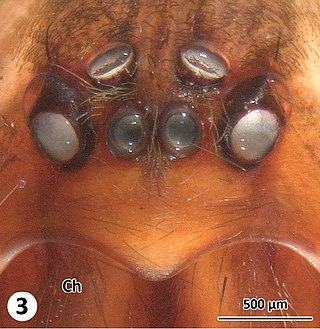
Austrochilidae is a small spider family with nine species in two genera. Austrochilus and Thaida are endemic to the Andean forest of central and southern Chile and adjacent Argentina.
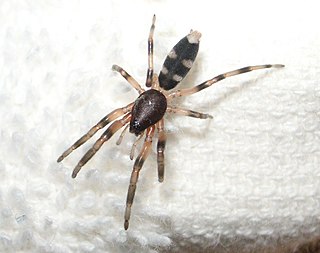
Lamponidae is a family of spiders first described by Eugène Simon in 1893. It contains about 200 described species in 23 genera, most of which are endemic to Australia, with the genus Centrocalia endemic to New Caledonia, and two Lampona species also occurring in New Zealand where it is commonly known as the "White Tail" spider. Lampona papua is endemic to New Guinea, where two otherwise Australian species also occur.

Stenochilidae is a family of southeast Asian araneomorph spiders that produce ecribellate silk. First described by Tamerlan Thorell in 1873, it now contains twelve described species in two genera.
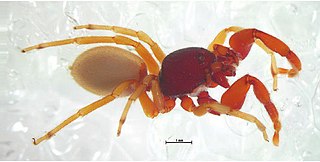
The Palpimanoidea or palpimanoids, also known as assassin spiders, are a group of araneomorph spiders, originally treated as a superfamily. As with many such groups, its circumscription has varied. As of September 2018, the following five families were included:
Lygromma is a spider genus of Central and South America. There are species with eight, six and no eyes. The eyeless L. anops is endemic to Galapagos, while the not closely related blind L. gertschi is found only on Jamaica.

Caponiidae is a family of ecribellate haplogyne spiders that are unusual in a number of ways. They differ from other spiders in lacking book lungs and having the posterior median spinnerets anteriorly displaced to form a transverse row with the anterior lateral spinnerets. Most species have only two eyes, which is also unusual among spiders. A few species of Caponiidae variously have four, six or eight eyes. In some species the number of eyes will increase when the spiderling changes its skin as it grows towards adulthood.

Trachelidae is a family of araneomorph spiders first described by Eugène Simon in 1897 as a subfamily called "Tracheleae". The Trachelidae family, also known as "ground sac spiders", is within the group of spiders known as the RTA clade, which includes mostly wandering spiders that do not use webs. Spiders in the Trachelidae family are characterized as being 3-10mm long and having a red cephalothorax and a yellow/tan abdomen. They are commonly found indoors. It was placed in the family Clubionidae, then later in Corinnidae when the Clubionidae were split up. The first study that suggested Trachelidae should be considered its own family was done by Deeleman-reinhold in 2001 as part of an analysis of RTA Clade spiders. An analysis by Martín J. Ramírez in 2014 suggested that it was not closely related to other members of the Corinnidae, and was better treated as a separate family. It was then placed in the CTC clade of spiders, or the Claw Tuft Clasper clade, which is a group of spiders that have two tarsal claws with tufts of hair.
Nigorella aethiopica is the type species of the genus Nigorella. A jumping spider that lives in Ethiopia and named in honour of the country in which it is found, it was first described in 2008 by Wanda Wesołowska and Beata Tomasiewicz. The spider is larger than others in the species with a cephalothorax that is between 4.1 and 4.8 mm long and an abdomen that is between 4.3 and 5.6 mm long. The carapace is generally brown and hairy, although the male is darker. While the male abdomen is marked by a light stripe on the topside and dots underneath, the female abdomen has a pattern of a light stripe and patches on the top and dark stripes on the bottom. As well as the larger size, there is a split at the end of the appendage on the pedipalp tibia that marks out the male, and the female has longer seminal ducts and thinner spermathecae than others in the genus.
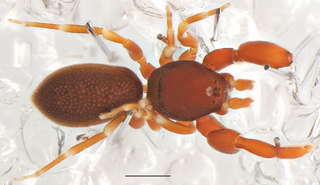
Diaphorocellus is a genus of African palp-footed spiders that was first described by Eugène Louis Simon in 1893.
Notiothops is a genus of Chilean palp-footed spiders that was first described by Norman I. Platnick, C. J. Grismado & M. J. Ramírez in 1999.
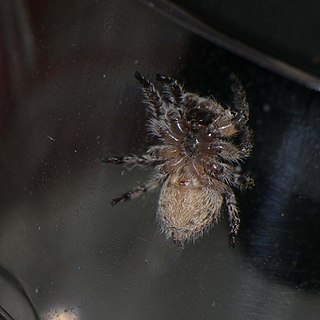
Langelurillus kenyaensis is a species of jumping spider in the genus Langelurillus that is endemic in Kenya. It was first described in 2016 by Angelika Dawidowicz and Wanda Wesołowska, and is named after the country where it was first identified. The spider is small, with a black oval carapace that is typically 2.8 mm (0.11 in) long and a blackish-grey spherical abdomen 2.2 mm (0.087 in) long. The short legs are orangish-brown have large dark markings, brown hairs and brown spines. Only the female has been described. It has a small epigyne and longer seminal ducts that are looped, which distinguishes it from the otherwise similar Langelurillus primus.
Neaetha catula is a species of jumping spider in the genus Neaetha that lives in East and Southern Africa. The male was first described in 1886 by Eugène Simon and the female by Ludovico di Caporiacco in 1949. First discovered in Zanzibar, examples have also been identified in Kenya. The spider is small, 3 mm (0.12 in) long, with a generally black cephalothorax and abdomen, although the abdomen has a pattern of spots towards the rear and a thin line that divides it in two. The species can be distinguished from others in the genus by the lack of central pocket in the female's epigyne. This feature led Dmitri Logunov to consider whether the spider belongs to the genus.


















